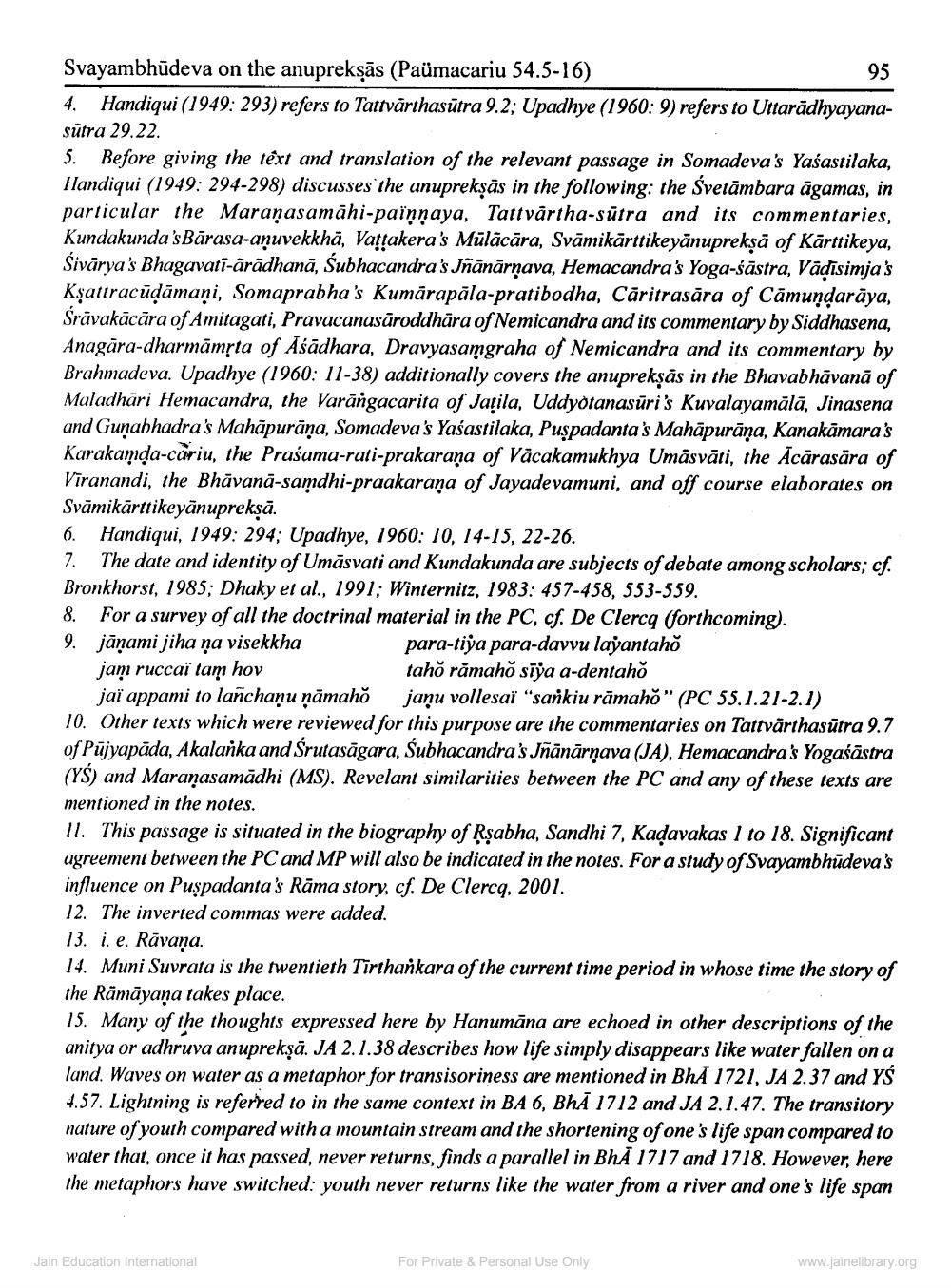________________
Svayambhūdeva on the anupreksās (Paümacariu 54.5-16) 4. Handiqui (1949: 293) refers to Tattvārthasūtra 9.2; Upadhye (1960: 9) refers to Uttarādhyayanasutra 29.22. 5. Before giving the text and translation of the relevant passage in Somadeva's Yaśastilaka, Handiqui (1949: 294-298) discusses the anuprekşās in the following: the Svetāmbara āgamas, in particular the Maranasamāhi-païnnaya, Tattvārtha-sūtra and its commentaries, Kundakunda's Bārasa-aņuvekkhä, Vattakera's Mülācāra, Svāmikärttikeyānupreksă of Kārttikeya, Sivārya's Bhagavati-ārādhanā, Subhacandra's Jnānārņava, Hemacandra's Yoga-śāstra, Vādīsimja's Kşattracūļāmani, Somaprabha's Kumārapāla-pratibodha, Căritrasāra of Cāmundarāya, Srāvakācāra of Amitagati, Pravacanasāroddhāra of Nemicandra and its commentary by Siddhasena, Anagāra-dharmāmsta of Asādhara, Dravyasamgraha of Nemicandra and its commentary by Brahmadeva. Upadhye (1960: 11-38) additionally covers the anupreksas in the Bhavabhāvanā of Maladhāri Hemacandra, the Varāngacarita of Jațila, Uddyotanasūris Kuvalayamālā, Jinasena and Gunabhadra's Mahāpurāna, Somadeva's Yaśastilaka, Puspadanta's Mahāpurāna, Kanakamara's Karakamda-cariu, the Prasama-rati-prakarana of Vācakamukhya Umāsvāti, the Acārasära of Viranandi, the Bhāvanā-samdhi-praakarana of Jayadevamuni, and off course elaborates on Svāmikārttikeyānuprekşā. 6. Handiqui, 1949: 294; Upadhye, 1960: 10, 14-15, 22-26. 7. The date and identity of Umāsvati and Kundakunda are subjects of debate among scholars, cf. Bronkhorst, 1985; Dhaky et al., 1991; Winternitz, 1983: 457-458, 553-559. 8. For a survey of all the doctrinal material in the PC, cf. De Clercq (forthcoming). jāņami jiha na visekkha
para-tiya para-davvu layantaho jam ruccaï tam hov
taho rāmaho siya a-dentaho jaï appami to lañchaņu ņāmahỏ jaņu vollesaï “sarkiu rāmaho" (PC 55.1.21-2.1) 10. Other texts which were reviewed for this purpose are the commentaries on Tattvārthasūtra 9.7 of Pujyapāda, Akalanka and Srutasāgara, Subhacandra's Jnānārnava (JA), Hemacandra's Yogaśāstra (YS) and Maranasamādhi (MS). Revelant similarities between the PC and any of these texts are mentioned in the notes. II. This passage is situated in the biography of Rsabha, Sandhi 7, Kadavakas 1 to 18. Significant agreement between the PC and MP will also be indicated in the notes. For a study of Svayambhūdeva's influence on Puspadanta's Rāma story, cf. De Clercq, 2001. 12. The inverted commas were added. 13. i.e. Rāvaņa. 14. Muni Suvrata is the twentieth Tīrthankara of the current time period in whose time the story of the Rāmāyaṇa takes place. 15. Many of the thoughts expressed here by Hanumāna are echoed in other descriptions of the anitya or adhruva anuprekşā. JA 2.1.38 describes how life simply disappears like water fallen on a land. Waves on water as a metaphor for transisoriness are mentioned in BhA 1721, JA 2.37 and YŚ 4.57. Lightning is referred to in the same context in BA 6, BhA 1712 and JA 2.1.47. The transitory nature of youth compared with a mountain stream and the shortening of one's life span compared to water that, once it has passed, never returns, finds a parallel in BhĀ 1717 and 1718. However, here the metaphors have switched: youth never returns like the water from a river and one's life span
Jain Education International
For Private & Personal Use Only
www.jainelibrary.org




